| Pages:
1
2 |
wg48temp9
National Hazard
   
Posts: 761
Registered: 30-12-2018
Location: not so United Kingdom
Member Is Offline
|
|
I just checked out your link, its a good compliment to this thread and interesting display of the various colours of molybdeum solutions.
I am wg48 but not on my usual pc hence the temp handle.
Thank goodness for Fleming and the fungi.
Old codger' lives matters, wear a mask and help save them.
Be aware of demagoguery, keep your frontal lobes fully engaged.
I don't know who invented mRNA vaccines but they should get a fancy medal and I hope they made a shed load of money from it.
|
|
|
Bedlasky
International Hazard
    
Posts: 1219
Registered: 15-4-2019
Location: Period 5, group 6
Member Is Offline
Mood: Volatile
|
|
Thanks.
I am preparing article about Mo complexes (but I don't have much time right know). This is also colourful and spectacular chemistry. Molybdenum is
really chameleon among elements.
|
|
|
Bezaleel
Hazard to Others
  
Posts: 444
Registered: 28-2-2009
Member Is Offline
Mood: transitional
|
|
Quote: Originally posted by Bedlasky  | wg48temp9: Thank you very much for your post! You help me to explain one mystery. A few days ago I want to take a picture of sodium phosphomolybdate
solution. I dissolved some Na2MoO4 in water, add tiny amount of K2HPO4 and add few drops of conc. HCl. I obtained yellow solution. But when I added
more phosphate, I obtained yellow precipitate, which was surprise for me. Now I know why. I used POTASSIUM hydrogen phosphate. When I repeated this
experiment today, I used NaH2PO4 instead of K2HPO4. I added just a tiny amount of phosphate and obtained yellow solution. When I added more phosphate,
solution became colourless - which corresponds with my previous observations.
So sodium phosphomolybdate is interesting reagent for K+, NH4+ and Rb+ test.
Btw - when you add K+, NH4+ or Rb+ salt in to the solution of sodium silicomolybdate, you obtain also yellow precipitate. Reaction with Rb+ is
immediate, while reaction with NH4+ and K+ requieres heating. |
Yesterday I prepared ammonium phosphomolybdate. This was a test to check the colour of this compound.
A crystal of 1x0.5cm of ammoniumparamolybdate (NH4)6Mo7O24.4H2O and ~10ml of water were gently heated until a completely clear and colourless solution
was formed. The solution was split in two parts of similar volume.
1. To one part, 1ml 85% (ortho)phosphoric acid (H3PO4) was added in a test tube. The mixture was shaken and heated, but no change in colour took
place. 2 ml of 10% HNO3 solution were added without change of colour. When it was heated shortly to ~80C, the solution stayed clear but turned yellow;
when cooled, it became colourless again after a few minutes. This turning yellow on brief heating and discolouring on cooling was repeated a few times
- the reaction seems reversible.
When heated for a few minutes to boiling, a very fine yellow precipitate was formed and the solution turned yellow. After a few hours, a fine
precipitate had settled. The supernatant liquid was then colourless, with a some microscopically fine yellow powder on its surface.
2. Likewise, the other part was put into a small flask and converted to ammonium phosphomolybdate by adding 85% H3PO4 and 10% HNO3 solution and
boiling briefly. To this an equal volume of 10% HCl solution was added. This was boiled for ~5 minutes and water was added as needed. No changes were
observed.
Results 1 and 2 after standing for 1 day are shown here:
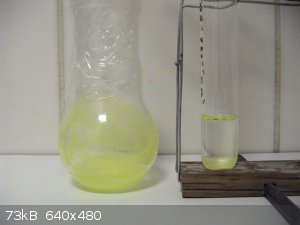
I did another experiment. A strong solution of MoO3 in 36%HCl is green in colour. From this solution, 1ml was taken, and 1.5ml of 85% H3PO4 were
added. The mixture was shaken. No reaction or change in colour was observed. When water was added (~5ml), the colour immediately turned deep blue.
When heated, no changes were seen. The colour disappeared when a soda solution (Na2CO3) was added. No further changes took place when boiling the
result. Adding 2ml of 10% HNO3 made no visible changes, neither after boiling
Extra H3PO4 and more HNO3 were added, but no changes were observed, neither after boiling or standing for a day.
Question: Is the presence of chloride known to prevent the formation of phosphomolybdate?
[Edited on 19-6-2020 by Bezaleel]
|
|
|
Bedlasky
International Hazard
    
Posts: 1219
Registered: 15-4-2019
Location: Period 5, group 6
Member Is Offline
Mood: Volatile
|
|
Interesting observations!
I made phosphomolybdate solutions with H2SO4, HNO3 and HCl without any problems, so chloride ions doesn't interfer.
With sodium molybdate and sodium dihydrogenphosphate I made two different phosphomolybdate solutions - one yellow and one colourless. If you add small
amount of sodium dihydrogenphosphate (it must be sodium salt, with potassium or ammonium salt you obtain yellow precipitate) in to acidified sodium
molybdate solution, you obtain yellow solution. If you add more phosphate, solution become colourless. If you add more molybdate, solution become
yellow again. This probably affected your experiment. But it's interesting that ammonium salt didn't precipitated out. I don't know why, but it is
probably caused by conditions.
It's also interesting that this equilibrium also depending on temperature. I'll definitely try it.
MoO3 solution in conc. HCl is green? That's something new to me  . Deep blue
solution is mistery. Normally I guess molybdenum blue, but there wasn't any reducing agent and soda solution doesn't affect molybdenum blue. . Deep blue
solution is mistery. Normally I guess molybdenum blue, but there wasn't any reducing agent and soda solution doesn't affect molybdenum blue.
Thanks for sharing your observations. 
[Edited on 20-6-2020 by Bedlasky]
|
|
|
plastics
Hazard to Others
  
Posts: 141
Registered: 6-11-2009
Member Is Offline
Mood: No Mood
|
|
Interesting stuff!
I am interested in an analytical test to identify/check rubidium and caesium salts.
I bought some ‘cheap’ rubidium chloride years ago to make rubidium metal - never quite got round to it - but was going for high temp reduction
with lithium.
I have been looking for a suitable test and found this paper that uses phospho and silico molybdic acids
I have have ordered some phospho molybdic acid and looking for the silicon version
Attachment: 7209121.pdf (657kB)
This file has been downloaded 389 times
|
|
|
Bedlasky
International Hazard
    
Posts: 1219
Registered: 15-4-2019
Location: Period 5, group 6
Member Is Offline
Mood: Volatile
|
|
Look at woelen's webpage. There are some interesting tests for caesium.
https://woelen.homescience.net/science/chem/exps/CsCuCl3/ind...
Sodium silicomolybdate is in my opinion better reagent for distinguish K and Rb, because K salts precipitates out only after heating. Sodium
silicomolybdate solution can be easily prepared in this way: In to the solution of sodium molybdate add small amount of sodium silicate and then add
1ml of conc. HCl at once (ideally with stirring). If too much silicate is present then hydrous SiO2 precipitates out, so add only small amount!
Another way is flame test. Colour of K, Rb and Cs flames are simmilar, but Rb have more bluish flame than K (I never saw Cs flame, but I suppose that
it will be even more bluish).
|
|
|
Bezaleel
Hazard to Others
  
Posts: 444
Registered: 28-2-2009
Member Is Offline
Mood: transitional
|
|
Quote: Originally posted by Bedlasky  | Interesting observations!
I made phosphomolybdate solutions with H2SO4, HNO3 and HCl without any problems, so chloride ions doesn't interfer.
With sodium molybdate and sodium dihydrogenphosphate I made two different phosphomolybdate solutions - one yellow and one colourless. If you add small
amount of sodium dihydrogenphosphate (it must be sodium salt, with potassium or ammonium salt you obtain yellow precipitate) in to acidified sodium
molybdate solution, you obtain yellow solution. If you add more phosphate, solution become colourless. If you add more molybdate, solution become
yellow again. This probably affected your experiment. But it's interesting that ammonium salt didn't precipitated out. I don't know why, but it is
probably caused by conditions. |
This well explains what I ran into: too much phosphate forms a Mo complex which is richer in phosphate. Such complexes are colourless and their salts
are normally well soluble.
Here are page 660 and 661 from Mellor, vol XI, about the various phosphomolybdates, which supports your observations.
Attachment: Mellor vol XI - phosphomolybdates p660-661.pdf (1.9MB)
This file has been downloaded 329 times
This table is taken from it and gives a synopsis of the ratios between Mo and P at which complexes have been found:
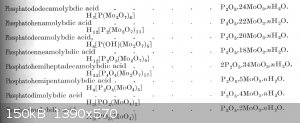
Quote: Originally posted by Bedlasky  | It's also interesting that this equilibrium also depending on temperature. I'll definitely try it.
MoO3 solution in conc. HCl is green? That's something new to me  . .
|
If concentrated HCl solution is used, and copious amounts of MoO3 are added, it is indeed green:

It's really striking how much MoO3 can be dissolved in concentrated HCl solution.
Quote: Originally posted by Bedlasky  | Deep blue solution is mistery. Normally I guess molybdenum blue, but there wasn't any reducing agent and soda solution doesn't affect molybdenum blue.
Thanks for sharing your observations. 
[Edited on 20-6-2020 by Bedlasky] |
This has to do with the HCl concentration, I think. I only observed the green complex in concentrated HCl with larger amounts of MoO3 added. I think
that when the green complex is broken down, some molybdenum blue is formed.
|
|
|
Bedlasky
International Hazard
    
Posts: 1219
Registered: 15-4-2019
Location: Period 5, group 6
Member Is Offline
Mood: Volatile
|
|
Quote: Originally posted by Bezaleel  |
This has to do with the HCl concentration, I think. I only observed the green complex in concentrated HCl with larger amounts of MoO3 added. I think
that when the green complex is broken down, some molybdenum blue is formed.
|
I don't think so. MoO3 is only weak oxidant, it can't oxidize HCl. But it forms few chloride complexes - maybe is one of them blue?
Book 1
Book 2
These two books mentioned [MoO2Cl2(H2O)2], [MoO2Cl3(H2O)]- and [MoO2Cl4]2- complexes. Book 2 also mentioned that [MoO2Cl2(H2O)2] is formed in 6M HCl
and [MoO2Cl4]2- is formed in 12M HCl. But they didn't mentioned colour. (Book 1 - page 734, Book 2 - there aren't number of pages, just find title
Mo(VI)).
[Edited on 26-6-2020 by Bedlasky]
|
|
|
Bedlasky
International Hazard
    
Posts: 1219
Registered: 15-4-2019
Location: Period 5, group 6
Member Is Offline
Mood: Volatile
|
|
Bezaleel: I try today make this Mo(VI) chloride complex. I poured small amount of concentrated HCl in to the test tube and dissolved in it some
ammonium heptamolybdate. I obtained yellow solution. On direct sunlight looked yellow, but when I put it in to the shadow it looked blue or
bluish-green depending on angle of view.
When I dissolved ammonium heptamolybdate in hot acid, some solid precipitates out after some time (probably MoO3). It was almost insoluble in water.
Dissolved in NaOH and even better in H2O2.
I'll probably try make some MoO3 from ammonium heptamolybdate and dissolve it in HCl if there will be some difference.
|
|
|
Bedlasky
International Hazard
    
Posts: 1219
Registered: 15-4-2019
Location: Period 5, group 6
Member Is Offline
Mood: Volatile
|
|
So there are another observations:
With MoO3 there isn't any change in colour. If you dissolve molybdate or MoO3 in commercial 31% HCl, there is formation of light yellow solution, in
pure 36% stuff it's bright yellow. Under UV light it's green with yellow tinge. If you dissolve too much molybdate in HCl and place solution in hot
water bath, after some time there is formation of MoO3 precipitate which dissolves after adding more HCl. After dilution with water solution lost his
colour. Few times there was partial reduction in to molybdenum blue (which can be oxidized by two drops of KMnO4 solution), but I don't know why.
Maybe some contamination?
Wiki says, that MoO2Cl2 is yellow compound.
https://en.wikipedia.org/wiki/Molybdenum_dichloride_dioxide
But there is also mentioned green MoOCl4.
https://en.wikipedia.org/wiki/Molybdenum_oxytetrachloride
I don't know why your observation is different from mine. There are two possible reasons:
1. Your MoO3 is contaminated with some reducing agent and there is molybdenum blue formation. Yellow + blue = green.
2. Or you prepare different chloride complex.
|
|
|
wg48temp9
National Hazard
   
Posts: 761
Registered: 30-12-2018
Location: not so United Kingdom
Member Is Offline
|
|
Here is an observation of mine:
I had a dilute solution of what I assumed was molybdic acid in a test tube, Mo dissolved in 12% H2O2. I had removed the screw cap about a month ago.
As the water evaporated the slight yellow colour became more intense with a tinge of orange in sunlight. Recently I put the solution into a small
beaker and placed it on a 80C hot plate. After the solution had been reduced to about half its volume it was a brown and cloudy reminiscent of an
oxidised ferrous sulphate solution without any green colour. Eventual I was left with dark brown deposit in the beaker which was actually a mush of
dark brown granules with dry almost black with a metallic lustre crust.
The only compound I think it could be is MoO2 but it has never been heater past about 80C certainly not 400C because at the same hot plate I was
evaporating a sugar solution which was now only transparent brown syrup with a slight caramel smell.
What is the dark brown mush?
According a wiki page MoO2 will combine with iodine to form volatile species MoO2I2. I could not find any info on that compound.
PS I will post pics of the brown mush later
[Edited on 8/22/2020 by wg48temp9]
I am wg48 but not on my usual pc hence the temp handle.
Thank goodness for Fleming and the fungi.
Old codger' lives matters, wear a mask and help save them.
Be aware of demagoguery, keep your frontal lobes fully engaged.
I don't know who invented mRNA vaccines but they should get a fancy medal and I hope they made a shed load of money from it.
|
|
|
Bedlasky
International Hazard
    
Posts: 1219
Registered: 15-4-2019
Location: Period 5, group 6
Member Is Offline
Mood: Volatile
|
|
Try dissolve small amount of it in water. Maybe it is solid peroxide complex. I doubt that it is MoO2, because H2O2 oxidize tetravalent molybdenum to
hexavalent.
|
|
|
wg48temp9
National Hazard
   
Posts: 761
Registered: 30-12-2018
Location: not so United Kingdom
Member Is Offline
|
|
Quote: Originally posted by Bedlasky  | | Try dissolve small amount of it in water. Maybe it is solid peroxide complex. I doubt that it is MoO2, because H2O2 oxidize tetravalent molybdenum to
hexavalent. |
The original solution had H2O2 in excess which I assumed has decayed because when it was now heated no oxygen or any gas bubbled out. You could be
right perhaps the excess H2O2 reacted slowly to form a yellow/orange coloured peroxide complex but if it did its stable to about 80C. The mush stains
paper orange yellow. The crust is electrical conductive (>100ohms between sharp points 10mm apart) as is the dioxide, but the crust may not be dry.
The material redissolves in water to form a orange/brown solution.
The mush when slowly heated in air to about 400C: it first bubbles and expands then drys/decomposes to a friable foam brown on the inside and a shinny
black outer surface.
I would expect a H2O2 complex to leave the white trioxide.
To be certain I am not fooling myself I will recreate the original solution and see if it behaves the same.
MoO2I2 is molybdenum oxyiodide. Apparently I2 reacts with the dioxide reversibly so it may be a way of depositing the conductive dioxide on glass.
I am wg48 but not on my usual pc hence the temp handle.
Thank goodness for Fleming and the fungi.
Old codger' lives matters, wear a mask and help save them.
Be aware of demagoguery, keep your frontal lobes fully engaged.
I don't know who invented mRNA vaccines but they should get a fancy medal and I hope they made a shed load of money from it.
|
|
|
Bedlasky
International Hazard
    
Posts: 1219
Registered: 15-4-2019
Location: Period 5, group 6
Member Is Offline
Mood: Volatile
|
|
Quote: Originally posted by wg48temp9  |
The original solution had H2O2 in excess which I assumed has decayed because when it was now heated no oxygen or any gas bubbled out.
|
Peroxide complexes, which are formed in acidic solution, are quite stable. Heating or UV light doesn't cause decomposition. On the other hand
complexes from alkaline solution are thermally unstable and UV sensitive and quickly decomposes in to molybdate and oxygen.
|
|
|
vano
National Hazard
   
Posts: 661
Registered: 22-3-2019
Location: Georgia
Member Is Offline
|
|
Has anyone made solid molybdenum blue? Or do you have a methodic of its prepatarion?
|
|
|
wg48temp9
National Hazard
   
Posts: 761
Registered: 30-12-2018
Location: not so United Kingdom
Member Is Offline
|
|
It can be made by dissolving molybdenum metal in 10% hydrogen peroxide at room temperature. Initially a yellowish solution of is formed formed with
some bubbling which I assumed was the decomposition of the H2O2. If the Mo is in excess when the H2O2 is used up by oxidation of the Mo or
decomposition, the Mo reduces the yellow solution to a solution of Mo blue. That solution can be evaporate to leaving dark blue solid Mo blue.
There is at least one thread on the subject.
I am wg48 but not on my usual pc hence the temp handle.
Thank goodness for Fleming and the fungi.
Old codger' lives matters, wear a mask and help save them.
Be aware of demagoguery, keep your frontal lobes fully engaged.
I don't know who invented mRNA vaccines but they should get a fancy medal and I hope they made a shed load of money from it.
|
|
|
Lion850
National Hazard
   
Posts: 514
Registered: 7-10-2019
Location: Australia
Member Is Offline
Mood: Great
|
|
Hi Vano when I made a basic moly blue the dry product was so dark blue it almost looks black. But when wetted and smeared on a surface it's blue. The
only info I have right now is that it was made from "MoO3, HCl, and Zinc metal". When I get back to the shed tomorrow I can try to find the log book
entry. Attached some photos, sorry for the poor quality.
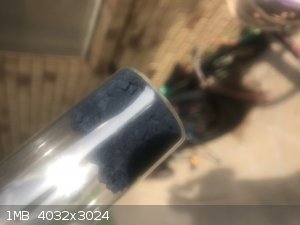 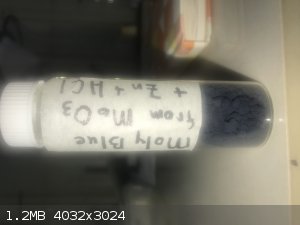
|
|
|
vano
National Hazard
   
Posts: 661
Registered: 22-3-2019
Location: Georgia
Member Is Offline
|
|
thanks! I saw your post about it, but the link doesn't work if you remember procedures ill glad if you tell me.
|
|
|
Lion850
National Hazard
   
Posts: 514
Registered: 7-10-2019
Location: Australia
Member Is Offline
Mood: Great
|
|
Hi Vano I found my notes:
- 11g MoO3 in 50ml water in a beaker
- Add 5.1g zinc granules
- Add 10ml concentrated HCl
- Stir. The white suspended MoO3 should turn blue.
(at this point I stopped for the night and continued the next day)
- Filter. Wash once in funnel with water. (Not recorded in the notes, but I seem to recall that at this point I simply used a tweezers to remove some
unreacted zinc metal)
- Dry in desiccator for 2 days (which for me is always over NaOH and under vacuum).
- 12g was recovered.
I also found the sample, and now after 2 years the upper third has changed back to white. Seems it slowly reacted with the bit of oxygen in the vial
over time? Or maybe it was not fully dry?
If you make some let us know how it goes.
|
|
|
vano
National Hazard
   
Posts: 661
Registered: 22-3-2019
Location: Georgia
Member Is Offline
|
|
Thank you so much!
|
|
|
vano
National Hazard
   
Posts: 661
Registered: 22-3-2019
Location: Georgia
Member Is Offline
|
|
Mine also is completely black. it has a very weak bluish color. I started with 33g of MoO3.
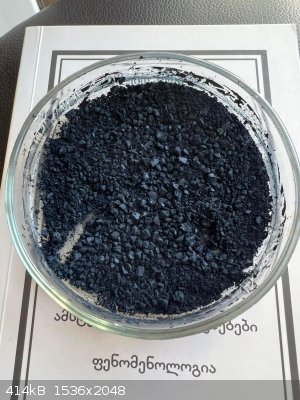
[Edited on 7-7-2022 by vano]
|
|
|
| Pages:
1
2 |